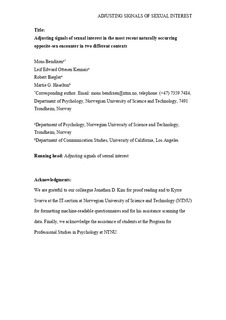| dc.contributor.author | Bendixen, Mons | |
| dc.contributor.author | Kennair, Leif Edward Ottesen | |
| dc.contributor.author | Biegler, Robert | |
| dc.contributor.author | Haselton, Martie G. | |
| dc.date.accessioned | 2019-12-05T07:47:27Z | |
| dc.date.available | 2019-12-05T07:47:27Z | |
| dc.date.created | 2019-10-25T13:59:50Z | |
| dc.date.issued | 2019 | |
| dc.identifier.citation | Evolutionary Behavioral Sciences. 2019, 13 (4), 345-365. | nb_NO |
| dc.identifier.issn | 2330-2925 | |
| dc.identifier.uri | http://hdl.handle.net/11250/2631840 | |
| dc.description.abstract | Sexual signaling is subject to manipulation, and miscommunication may occur because of biased interpretations of signals, or because of strategical downplaying of sexual interest (playing hard-to-get). In this paper, we examined initial perceptions of cues from opposite sex partners along with participant reported own sexual attraction and signaled attraction in their most recent natural occurring potentially sexual opposite-sex encounter. Data on heterosexual Norwegian male and female students were collected in two largely different social contexts (during Regular Study Period, Spring 2015: N = 224 and during Freshmen Weeks, Early Fall 2015: N = 211). Results show no indication of women playing hard-to-get, or of strategically downplaying signals of sexual attraction. There was evidence of male sexual overperception in Study 1, but this effect was not replicated in Study 2 mainly due to increased levels of sexual attraction in single, freshmen women in that particular social context. For both sexes, reported levels of signaled attraction strongly reflected reports of own sexual attraction. Predictors for who ended up having sex after the encounter differed for women and men. For women, ending up having sex was predicted by the other’s short-term mate value, being freshman, and level of perceived sexual interest from the other after the encounter. For men, ending up having sex was predicted merely by their history of casual sex. It is concluded that women and men adjust their signals of sexual attraction upward or downward relative to their felt attraction to prompt further communication and to gain more information. | nb_NO |
| dc.language.iso | eng | nb_NO |
| dc.publisher | American Psychological Association | nb_NO |
| dc.relation.uri | http://dx.doi.org/10.1037/ebs0000162 | |
| dc.title | Adjusting Signals of Sexual Interest in the Most Recent Naturally Occurring Opposite-Sex Encounter in Two Different Contexts | nb_NO |
| dc.type | Journal article | nb_NO |
| dc.type | Peer reviewed | nb_NO |
| dc.description.version | acceptedVersion | nb_NO |
| dc.source.pagenumber | 345-365 | nb_NO |
| dc.source.volume | 13 | nb_NO |
| dc.source.journal | Evolutionary Behavioral Sciences | nb_NO |
| dc.source.issue | 4 | nb_NO |
| dc.identifier.doi | http://dx.doi.org/10.1037/ebs0000162 | |
| dc.identifier.cristin | 1740649 | |
| dc.description.localcode | © American Psychological Association, [2019]. This paper is not the copy of record and may not exactly replicate the authoritative document published in the APA journal. Please do not copy or cite without author's permission. The final article is available, upon publication, at http://dx.doi.org/http://dx.doi.org/10.1037/ebs0000162 | nb_NO |
| cristin.unitcode | 194,67,40,0 | |
| cristin.unitname | Institutt for psykologi | |
| cristin.ispublished | true | |
| cristin.fulltext | preprint | |
| cristin.fulltext | original | |
| cristin.fulltext | postprint | |
| cristin.qualitycode | 1 | |
